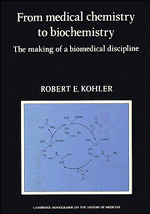Book contents
- Frontmatter
- Contents
- 1 Introduction: On discipline history
- 2 Physiological chemistry in Germany, 1840–1900
- 3 Physiology and British biochemists, 1890–1920
- 4 General biochemistry: the Cambridge school
- 5 European ideals and American realities, 1870–1900
- 6 The reform of medical education in America
- 7 From medical chemistry to biochemistry: the emergence of a discipline
- 8 Unity in diversity: the American Society of Biological Chemists
- 9 The clinical connection: biochemistry as applied science
- 10 Chemical ideals and biochemical practice
- 11 Biological programs
- 12 Epilogue: Toward a molecular biology?
- Location of archival sources and abbreviations
- Notes
- Index
6 - The reform of medical education in America
Published online by Cambridge University Press: 07 October 2011
- Frontmatter
- Contents
- 1 Introduction: On discipline history
- 2 Physiological chemistry in Germany, 1840–1900
- 3 Physiology and British biochemists, 1890–1920
- 4 General biochemistry: the Cambridge school
- 5 European ideals and American realities, 1870–1900
- 6 The reform of medical education in America
- 7 From medical chemistry to biochemistry: the emergence of a discipline
- 8 Unity in diversity: the American Society of Biological Chemists
- 9 The clinical connection: biochemistry as applied science
- 10 Chemical ideals and biochemical practice
- 11 Biological programs
- 12 Epilogue: Toward a molecular biology?
- Location of archival sources and abbreviations
- Notes
- Index
Summary
The “heroic” period of medical reform in America was dominated by individuals who cultivated German ideals in a hostile environment. Strategies were improvised; success depended on special local circumstances. After 1900 medical reform was increasingly a collective enterprise, led by national organizations and carried out systematically on a regional or national scale. The Association of American Medical Colleges organized the first survey of colleges in 1900, and the Council on Medical Education of the American Medical Association organized for reform in 1904. The celebrated Flexner Report of 1910 was backed by the Carnegie Foundation, and Flexner pursued his reform ideals as an officer of the Rockefeller General Education Board. Strategies were orchestrated and standardized, and reform spread rapidly from leading schools to every medical college. Institutions that did not meet the new standards were allowed to perish. The number of medical schools reached a peak of about 160 between 1900 and 1906 and then plummeted to about 80 in the 1920s (see Table 6.1). Medical institutions were radically restructured to support new ideals and roles. A national market in the biomedical sciences was created in which competition for the best faculty and well-trained students accelerated the transition from the old system to the new. Not since the reform of German universities half a century before had there been opportunities on such a scale for the creation or re-creation of biomedical disciplines.
- Type
- Chapter
- Information
- From Medical Chemistry to BiochemistryThe Making of a Biomedical Discipline, pp. 121 - 157Publisher: Cambridge University PressPrint publication year: 1982



